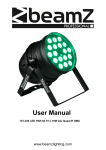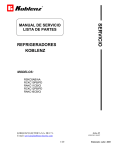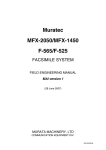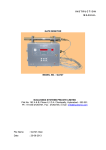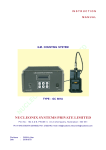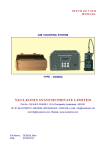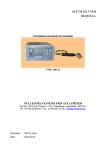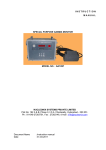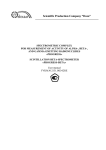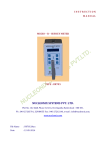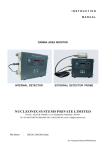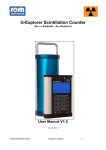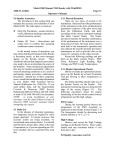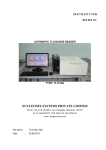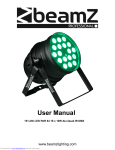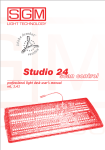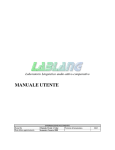Download product manual
Transcript
INSTRUCTION MANUAL RADIATION COUNTING SYSTEM (AT) TYPE : RC605A NUCLEONIX SYSTEMS PRIVATE LIMITED Plot No: 162 A & B, Phase II, I.D.A. Cherlapally, Hyderabad - 500 051. Ph : 91-040-27263701, Fax : 27262146, e-mail : [email protected] File Name Date : RC605A_Man : 13-08-2014 CONTENTS CHAPTER No. Title of the contents Page No. Unpacking CHAPTER I Introduction 04-05 CHAPTER II Technical Specifications 06 -11 CHAPTER III Front panel and Side panel controls / indications 12-14 CHAPTER IV Block diagram Description 15-16 CHAPTER V Operating Instructions 17-23 CHAPTER VI Procedure for Alpha / Beta Sample Activity Calculations 24-26 CHAPTER VII Calculations for minimum detectable activity 27 - 27 CHAPTER VIII Availing of equipment maintenance/ calibration services and warranty clause 28-31 2 UNPACKING Radiation Counting System Type: RC605A with accessories has been thoroughly tested and is dispatched in ready to assemble condition. However, on unpacking and prior to operation, it is advisable to check visually and make sure that there is no visible damage caused in transit. Also checkup the items (instrument / sub-systems/ accessories / cables etc.) physically by verifying with the packing list contents for correct types & quantities. Any discrepancy if found, may please be communicated by email to Head, Customer support division. Typical packed carton & wooden crates contain (a) Radiation counting system RC605A (b) Detector probe(s) with stand & other accessories including cables (c) Lead shielding (castle) for the detector probe All these items on receiving are to be unpacked carefully & inspected visually. If any damage to the instrument is observed, do not switch ON the unit and report the matter immediately to: Head CSD Customer Support Division Nucleonix Systems Private Limited Plot No: 162 A & B, PHASE II, I.D.A. Cherlapally, Hyderabad - 500 051. Ph : 91-040-27263701/30918055, FAX : 91-040-27262146, e-mail :[email protected] In all correspondence regarding the instrument, please mention the type, serial number of the unit, date of supply etc., of the unit. 3 CHAPTER - I INTRODUCTION Radiation Counting system, type RC605A manufactured by NUCLEONIX is a versatile state of art integral counting system designed around eight bit microcontroller chip for using with a variety of detector probes such as Alpha / Beta / Gamma Scintillator detector probe or End window G.M detector probe or thin walled G.M. detector probe(s). The system is suitable for counting Alpha, Beta and Gamma sample counting with appropriate detector probes. Radiation Counting System essentially has a processor card and other electronic circuits to generate continuously variable HV upto 1500V to be applied to scintillation detector Probes ( , , ) or End window G.M. detector(s), amplify the detector output and convert them to digital pulses for counting and displaying the recorded counts for a preset time. Microcontroller design facilitates programmability for background, standard and sample counting. The data can be downloaded into PC or printed directly onto a printer. System facilitates counting of samples either on planchets or filter paper. This system will find applications for counting of air activity, wipe, environmental, geological and other samples for both beta , gamma and alpha activity. Activity report is generated for unit volume of sample. FEATURES: System is designed confirming to ANSI N42.17 standards, to meet performance specifications. Complies to IS-9000 part III & V, for climatic test. Complies to interference test as per IEC61000 or equ. State of art microcontroller based design. 20 x 2 LCD dot-matrix display for counts, elapsed time and HV. Inter PCB connections are through Mother Board. All PCB Edge connectors are EURO type. Counts capacity 999999, preset time 9999 sec. Variable HV (0-1500V), 0.5mA. Store and Recall facility for data counts. Built-in parallel port for direct data printing Built in Ethernet connection to PC Programmability for lable assignment for a sample. Facilitates connection to Alpha & Beta and gamma probes for sample counting. Built in RTC. 4 Fig (1) RADIATION COUNTING SYSTEM (AT) TYPE: RC605A (with Alpha probe) (with Beta probe) (with Gamma probe) 5 CHAPTER – II TECHNICAL SPECIFICATIONS P.M. Input (From , , scintillation detector probe) : (a) Polarity : Negative (b) Amplitude : -100 mV (min) G.M. Input (From G.M. Counter) : (a) Polarity : Negative (b) Amplitude : -500 mV (min) (c) Built-in load resistor : 4.7 or 3.3M Ohms HV Output : HV (0-1500V) @1mA continuously variable through front panel keypad in steps of 1 volt, ripple less than 20mV, line & load regulation better than 0.05%. HV indication : On LCD dot-matrix provided. Display : 20 x 2 LCD dot-matrix display has been provided to indicate data counts, Elapsed Time and HV. Counts Capacity : 999999 counts Preset time : 1min to 24 hrs (HH : MM) format Overflow : > 999999 Counts / CPM > 99999 CPS Measuring range : 999999 Counts Storage capacity : 1000 readings. Data storage : Configuration parameters, sample particulars & data values. Count ON indication : Red LED Modes of operation : Preset time mode, Preset Count, CPS and CPM Preset cycles / Iterations : 1 to 10 Command Buttons : START, STOP, PROG, STORE, INC & DEC command buttons have been provided on the front panel key pad. Paralysis Time : A choice of three paralysis times 250, 350 and 550 micro sec plus OFF position selected through PROG key. Programmability : Includes selection of Preset Time, Storing / Recalling of data, starting and stopping of acquisition, label assignment for data counts BG (Background), ST (Standard) & SP (sample) etc,. RTC : Built in RTC provides real time clock information which is stamped in the activity report when printed. Built in Real time clock facilitates the user to generate sample analysis reports with RTC stamping. Both date, month & time in hrs and minutes are printed. Scintillation detector probe socket : This is a UHF socket for connecting to or scintillation Probe. G.M. Socket : MHV connector for connecting to G.M. Detector(s). Printer Port : Built-in centronics port facilitates connection to a printer for direct data printing selectively. 6 Ethernet Port : Bulit in Ethernet PCB facilitates data downloading into PC through Ethernet cable. Data Communication Software: Can be provided for serial transfer of data readings into PC. Power: This unit RC605 is powered through AC to DC [email protected] adaptor at jack. Operating Temperature: 0 to 50oC Relative Humidity: Upto 90% Type test compliances: Manufactured confirming to ANSI N 42.17. Complies to IS -9000 part III & V, for climatic test. Complies to Interference test as per IEC61000 or equ. Detector testing : Instrument has provision for interfacing with GM detectors of different types and makes. It is capable of calculating the plateau and slope of the detectors. For this purpose, the counting system can be programmed to vary the EHT in steps and to carry out the counting for a given time interval. Both the EHT step size and the counting time interval are user programmable/selectable. It also records the background counts of the detector at the operating voltage. The detector test data shall be stored and made available on command by host PC. Detector probe assemblies: Instrument is supplied with five types of detector probes, two type of GM detectors for Beta gamma and three types of scintillation detectors for alpha, beta and gamma as per the specifications given below. All these detector probe are suitably covered by adequate lead shielding with arrangement for loading of samples excepting for side window GM detector. End Window GM detector probe: Wide End window probe consisting of an End window (Halogen quenched) GM detector LND72314 or equivalent with 1” dia, 3-4 mg/cm^2 thickness mica window enclosed in a PVC enclosure fitted with MHV socket. Side Window GM detector: Side window probe with Halogen quenched GM detectors thin walled (25 - 30) mg/sq. cm. in a protective housing with a rotatable shutter for cutting off beta particles. This is used for measuring beta as well as gamma contamination. Alpha Scintillation Detector: Alpha detector assembly consists of an ZnS (Ag) Scintillator, approximately 20 mg /sq. cm on Perspex; covered by1mg/cm^2 aluminized, pin-hole free, light-resistant mylar film. The Scintillator is optically coupled to a suitable photomultiplier tube along with an appropriate low noise pre-amplifier etc. The probe is provided with a drawer arrangement for 1” dia / 2” dia sample filter paper, for air activity measurement. • • Detection Efficiency Probe Construction : : Greater than 25% for plutonium alphas over complete detector area. Suitable for table top mounting. With a strong base plate and drawer assembly with sample holder. Beta Scintillation detector: The beta scintillation detector consists of a Plastic Scintillator which is optically coupled to a suitable photomultiplier tube along with an appropriate low noise pre-amplifier etc. The detector assembly is housed in a lead castle with door arrangement for loading of samples. The probe is mounted on a base, provided with a drawer type arrangement for 1” dia / 2” dia sample filter paper measurement. • Probe Construction : Suitable for table mounting. With a strong base plate and drawer assembly with sample holder. Covered with lead shielding. Gamma Scintillation detector: The gamma scintillation detector supplies is of a NaI (TI) Scintillator of 2” dia x 2” thick or ordered size, which is optically coupled to a suitable photomultiplier tube along with an appropriate low noise pre-amplifier etc. The 7 detector assembly is housed in a lead castle with door arrangement for loading of samples. The probe shall be provided with a drawer type arrangement for 1“ dia / 2“ dia sample filter paper measurement. Computer Interface: The Counting system has an Ethernet PCB port for interfacing with a PC. The PC and the counting systems operate in a host-slave configuration in a multi-drop network through this interface. The PC as the host give commands and sends queries. The counting system carries out various functions as per the commands and provides required information in response to the queries. The firmware of the instrument is able to send the instrument data like Instrument ID, Instrument type, Input range, Display range, alarm settings, alarm data, current reading etc. to the Host PC on demand. The firmware is able to receive commands from Host PC and carry out the settings of different parameters like Instrument ID, Instrument type, Input range, Display range, alarm settings etc. Detailed list of the command and response for the Host-slave communication is provided to the user. Environment: The instrument is able to withstand temperature upto 50 deg C and relative humidity upto 90% in radiation areas. Mechanical Dimensions : 250mm(W) X135mm(H)X325mm(D) Approx. APPLICATIONS: This system can be used for counting or samples on a 25mm dia planchet or 47/50mm dia filter paper obtained from air samplers, or continuous air monitors in a Nuclear facility. System can also be used for wipe sample counting in nuclear counting lab of a Nuclear power plant or similar facility. 8 DETECTOR PROBE ACCESSORIES OFFERED WITH RADIATION COUNTING SYSTEM RC605A (A) ALPHA PROBE TYPE : AP 165 Alpha Probe type AP165 manufactured by NUCLEONIX is meant to be used along with Radiation Counting System model RC 605A for counting alpha samples. Radiation Counting System along with Alpha Probe essentially works as an Alpha Counting System. Alpha Probe of NUCLEONIX make is essentially an integration of ZnS (Ag) scintillator screen, optically coupled to a 2” PMT & covered by a pin hole free aluminized mylar foil to provide, sealing against ambient light. Scintillations received by PMT because of Alpha particles will be converted to electrical charge and inturn to voltage pulses. Each of these events after amplification in the RCS will be counted. The required high voltage is applied (which is typically 900V) through RCS to the Alpha Probe. Probe has a drawer assembly which facilitates sample placement on sample tray for counting applications. The counting samples are usually deposited on planchets of 25mm diameter or filter paper upto 38mm diameter. SPECIFICATIONS : Detector material : Zns (Ag) Screen covered with Aluminized mylar foil. Density : 10mg/cm2 Efficiency : Better than 25% for U-238 alpha or Am -241 Background counts : 5 to 6 counts in one hour Photomultiplier tube : PMT of ETL or Hamamatsu make or its equivalent. Size : 50.8 dia (2") Operating Voltage Range : 700 to 950V Drawer Assembly : Holds both 25mm dia SS planchets or 50mm dia filter paper. ALPHA STANDARD SOURCE : Am241 alpha standard source can be supplied as an optional item. This is an electro deposited source on an SS planchet. Typical activity is in the range of 3000 to 5000 dpm. (B) BETA PROBE ASSEMBLY TYPE : LS240 This is essentially an integration of the following units. i. Lead Castle LS 240 ii. G.M. Stand SG 200 iii. G.M. Detector GM 120 (or) iv. G.M. Detector GM 125 (or) v. Plastic Scintillation Detector (SBP2) The Lead Castle Type : LS 240 is designed to shield the G.M. Counters from background radiation. Lead Castle type LS 240 can house G.M. counters mounted on Geiger tube stand of NUCLEONIX make. The shield is of 45 mm thickness and is built up of six interlocking rings. The top and bottom are covered by similar interlocking discs. A door is fitted in the bottom ring with 150 degree opening to facilitate easy access to the sample holding tray of G.M. Stand. The door is fitted with heavy duty hinges and the inside of the lead shield is lined with thin aluminium sheet to minimize scattering. 9 (C) STAND FOR G.M. DETECTOR TYPE : SG 200 Stand for G.M. tube type SG 200 has been designed to hold end window G.M. tubes. This stand can be housed inside the lead shielding if required. It has both sample and absorber trays. The position of these trays can be adjusted from the end window of the detector. The stand made up of acrylic sheet is precisely milled for sliding-in of sample and absorber trays. Sample tray is made up of SS material designed to hold planchets or disc type radioactive standard source (Beta or Gamma). Aluminimum absorber discs can be interposed between the source and the detector for attenuating the radiation as seen by the detector. This stand is an essential accessory for connecting end window G.M. tube to any of the G.M. counting systems or Radiation Counting System manufactured by NUCLEONIX. (D) END WINDOW G.M. DETECTOR TYPE : GM 125 GM 125 is a Halogen Quenched, wide End Window GM Detector, supplied by NUCLEONIX. It is highly recommended for swipe sample counting of Beta samples by health Physics labs. Its operating voltage is approximately 500V. It has good plateau length and plateau slope. Its operating voltage is approximately 500V. It is enclosed in a PVC cylindrical enclosure for protection & supplied. An MHV socket provided on one side of the PVC enclosure facilitates one to connect to detector socket on rear panel of the counting system. SPECIFICATIONS Application : Suitable for Beta sample Counting Operating Voltage : Range : 450 - 750 V Tube Dimensions : Max. Over all length 1.93 inches. Gamma Sensitivity : 50 cps / mR/hr with Co-60 Background with 40mm lead shielding : < 20cpm Efficiency at (1 cm) : (typical) (a) Tl-204 - 15% (b) Sr-90 - 20% (c) Am-241 – 7% (d) Cs-137 – 3% Max. Diameter : 1.13 inches Gas filled : Ne + Hal End Window : mica 2.0 mg/cm sq. density (E) BETA SCINTILLATION PROBE (PLASTIC SCINTILLATION BASED) TYPE : SBP-2 Beta probe assembly type SBP-2 is a plastic scintillator based assembly consisting of ‘2’ Dia scintillator coupled to ‘2’ PMT. It has thin aluminized foil as Beta entrance window. It is primarily designed to serve as a Beta Probe when connected to a Radiation Counting System. Operating Voltage Range : 900–1000V Background (typical) with 40 mm lead shielding : < 110 cpm Efficiency (typical) for (a) Sr - 90 at 1 cm : > 40%, (b) Tl – 204 >18% 10 (F) GAMMA SCINTILLATION PROBE WITH STAND This essentially consists of a 2” x 2” NaI Integral detector, with PMT / HV bleeder wired & enclosed in a cylindrical shell with appropriate connector brought out for applying HV bias to PMT & also for taking signal output to the Radiation Counting System. This probe with NaI crystal facing downwards is placed in a sample holder having slotted arrangement for placing sample tray. Samples either filter paper deposited air activity sample or in a SS planchet can be kept for gross gamma activity counting. This Radiation counting system cannot be used for selection of a specific energy band. For applications requiring counting for a specific energy band one has opt for Gamma ray spectrometer. 11 MINIMUM DETECTABLE ACTIVITY The minimum detectable activity (MDA) is that amount of activity which is the same counting time gives a count which is different from the background by three times the standard deviation of the background counting rate : MDA = Bkg cpm + 3 X (Bkg)1/2 t Example : What is the MDA for a counter with a background of 750 counts in ten minutes ? MDA = 75 cpm + 3 X (750)1/2 10 min = 83 gross cpm Thus, any gross count over 83 cpm can be considered to be due to radioactivity. However, the MDA for a counting system must be expressed in terms of a net count so that the results can be converted to dpm or Ci. Thus, the MDA becomes : MDA = 3 X (Bkg)1/2 t To calculate the MDA (in dpm) for a known nuclide, divide by the efficiency of the nuclide. Report the MDA for any nuclide for which a net count of zero is calculated or whenever the standard deviation of the reduced by increasing the counting time and lowering the background. The lower the MDA, the more accurately the activity of samples with low counting low counting rates can be determined. Example : what is the MDA (in dpm) for a counter with a background of 750 counts in ten minutes and an efficiency of 50% for the nuclide of interest? MDA = 3 X 7501/2 10 min = 8 net cpm = = 16dpm or 7.2 X 10-6 Ci 1 Bq = 2.7 X 10-11 Ci 16 dpm = 0.266 dps = 0.266 Bq = 0.266 X 2.7 X 10-11 Ci = 0.7199 X 10-11Ci = 7.199 X 10-12 Ci = 7.2 X 10-6 Ci 12 CHAPTER - III FRONT & REAR PANEL CONTROLS & INDICATIONS 3.1. FRONT PANEL CONTROLS AND INDICATIONS 3.1.1. POWER ON SWITCH This is a miniature ROCKER switch which is used to power-up the unit. When the switch is put 'ON' the mains AC, power is made available to the unit. 3.1.2. INTELLIGENT KEYPAD (a) PROG key button: This key is an important key which facilities the user to programme for the operation of the instrument for different modes / conditions. More details are covered under "CHAPTER VII OPERATING INSTRUCTIONS". (b) START key button: This is used for starting of acquisition, once all the programme parameters have been set. (c) STOP key button: This key can be used to terminate acquisition and printing in between. In the normal course acquisition will stop automatically at the end of preset time. (d) INC/DEC key button: These keys are used while setting the programme parameters to increment and decrement a value or to change the option selected to another value available and also used for printing. (e) STORE key button: This key is used for storing the readings or data values in the following way, in the manual mode of storing only. At the end of acquisition for a preset time if user presses this button, data counts will be stored. 3.1.3. LCD DOTMATRIX DISPLAY This is a 20 X 2 alpha numeric LCD dot-matrix and responds to all the commands from the keypad and displays programme parameters, current HV, data counts, preset and elapsed time etc,. 3.2. REAR PANEL CONTROLS AND INDICATIONS 3.2.1. DC SOCKET This is used to connect 12V adaptor. 3.2.2. SCINT PROBE This is a UHF socket to which scintillation detector probe (Alpha or Beta plastic Scintillator based detector) or Gamma scintillation (NaI) detector of Nucleonix make or its equivalent can be connected through a MHV to UHF cable. The system will work as an Alpha / Beta / Gamma counting system under this condition with appropriate probe. 13 3.2.3. G.M DETECTOR This is a UHF socket to which End window GM detector GM125 (End window detector probe) or GM detector LND 72314 or its equivalent can be connected through a MHV to MHV cable. 3.2.4. TO PRINTER This is a 25 pin D-female connector through which one can connect a printer (with centronics interface cable) for direct printing of data. 3.2.5 EHT (0-1500V) MHV SOCKET : This is a HV output socket provided for checking HV output 3.2.6 MINIATURE BANANA / SOCKET TEST POINTS (for LV supplies) : These are provided on the rear panel as test points for +5V, +12V, +24V & GND. 3.2.7. TEST INPUT(S) A. GM : This is a BNC socket at which a ‘–ve test tail pulse’ is injected for testing of the functionality of the pulse processing & counting electronics circuits under simulated condition. B. Scintillation : This is a BNC socket on to which a –ve tail pulse of appropriate amplitude & fall time are injected to test, pulse processing & counting electronics part of the circuit, under simulated conditions. 3.2.8. Ethernet Connector Ethernet modbus connector on the rare panel have been provided for communication. 14 Fig. (a) Front view of Radiation counting system (RC605A) Fig. (b) Rear view of Radiation counting system (RC605A) 15 CHAPTER – IV BLOCK DIAGRAM DESCRIPTION While going through these following paragraphs, please refer to the block diagram given on the next page. This is an advanced Radiation counting system (RC605A) (Integral), table top model designed around microcontroller chip 89C51 and can be used with a choice of alpha/beta/gamma detector probes. This unit has a High Voltage PCB, Microcontroller PCB, Power supply / pulse processing circuits and 20X2 LCD dot-matrix display and a front panel tactile keypad. High Voltage circuit block : HV circuit PCB consists of DC to DC converter with external drive oscillator. This typically operates in the frequency range of 25 KHz to 35 KHz. A 555 oscillator is used. R.F. transformer steps up the voltage. A voltage doubler, filter, regulator etc., will give highly stable variable HV in the range of (0-1500V) @1mA/0.5mA. There is a 12 bit DAC which is programmed through microcontroller to set desired HV. This DAC output goes to HV circuit. Display for HV is achieved through a 10 bit ADC chip which logs fraction of HV and through microcontroller, it goes to LCD display under software control and HV is indicated. LV / Detectors / Pulse processing / Microcontroller and associated circuit blocks : The LV and pulse processing circuit PCB generates +5V & +12V & 24V required for circuit functioning. There are two detectors one G.M detector which receives +500V, HV bias from HV PCB. Detector pulses generated got to – ve tail to TTL converter. Another one is a scintillation detector. i.e., PMT with Alpha, Beta or Gamma Scintillator i.e., (ZnS or plastic or NaI respectively). On detection –ve tail pulses are generated at anode of PMT. Typical PMT bias may be +600V to +900V. Negative tail pulses from the G.M. tube or PMT Scintillator are processed by a pulse processing circuits to give a standard TTL pulses, which are sent 6 digit counter chip through Analog MUX, as indicated in block diagram. Analog MUX routes either (i) G.M pulses or (ii) scintillation detector pulses or (iii) Test pulses to 6 digit counter for counting purpose. In case of connection to scintillation probe (Alpha, Beta and Gamma probe) the scintillation pulses generated will be amplified further through a charge sensitive amplifier circuit which has a few amplifier stages followed by a comparator to discriminate noise & generate TTL pulses. These pulses go to the counter chip & are counted there. For every second, micro controller reads data from counter and it displays on the 20 X 2 LCD module. Once the preset time is completed microcontroller reads the data from counter and is presented to the display. Keypad has command buttons for user interface with instrument for programming and operation of the product under program / control. Unit has EEPROM for data storage and recall on to display when needed. There is a built-in printer port to facilitate printing of raw data as well as processed results which may include user specific calculations. There is a buffered (opto isolated) RS232/485 interface chip connected to microcontroller. RS232/485 signals are terminated on a 9-pin D-connector on the rear panel. Unit can be connected PC through this connector for data communication & programming. ‘Net Count’ software is exclusively designed by Nucleonix Systems for Networking of multiple counting systems to PC. 16 17 CHAPTER -V OPERATING INSTRUCTIONS 5.1. SYSTEM INTERCONNECTIONS Sl.no. 01 02 03 5.2. Connection From to 230 V A.C. Mains Mains Socket on Socket Rear Panel Beta Probe UHF Socket Beta Probe unit on Rear Panel of (GM stand) RC605 Personal computer RS485 9 pin serial D - connector on port (Optional) Rear Panel of RC605 Remarks cable to be used Application Mains cord to power ON the unit UHF to UHF RG59 cable of 1 meter length For Beta Probe RS485 serial cable for serial communication 04 Printer (Optional) Printer Connector on Rear Panel of RC605 25 pin D to D connector printer cable for data printing 05 UHF socket (alpha probe) on R.P. of RC605 Alpha probe unit UHF to UHF RG59 cable of 1 meter length For Alpha probe INSTRUCTIONS ON INTELLIGENT KEYPAD COMMANDS When we switch on the unit, the display will show up as below RC605A Sl.No XX NUCLEONIX SYSTEMS for 3 Sec. for 3 Sec. Now display appears as shown ACQ MODE SETUP Now user has to initially configure the instrument by selecting SETUP mode & set various parameters 5.2.1. TO ENTER SETUP MODE Select below menu option by pressing PROG if any other menu option is displayed ACQ MODE SETUP Now select using or buttons 'SET UP' mode if any other mode is displayed. Now by pressing 'PROG' button different sub-menu options under setup menu can be chosen. 18 5.2.1.1 PASSWORD SETTING Select below menu option by pressing PROG if any other menu option is displayed PASSWORD PASSWORD XXXX XXXX Now select using or buttons set the given password Now by pressing 'PROG' button different sub-menu options under setup menu can be chosen. 5.2.1.2. SELECTION OF DETECTOR TYPE Press 'PROG' key to select below menu option SELECT X X-current detector type ( / Test) Now to select detector type, change mode by using or keys to change the detector to Alpha, Beta / Gamma or Test 5.2.1.3. HV ADJUSTMENT Press 'PROG' key to select below menu option. SET HV XXXX Now select using or buttons set the given password The user can select appropriate HV by using or keys. The key is used to change cursor position & key is used to increment the particular digit. 5.2.1.4. PARALYSIS TIME Press 'PROG' key to select below menu option PARALYSIS TIME OFF The user can select appropriate paralysis time by using or keys. It can be set to OFF/250 sec/350 sec/550 sec 5.2.1.5. SELECTION OF INSTRUMENT ID Using this option assign a unique address to the instrument for RS485 Communications Press 'PROG' key to select below menu option INSTRUMENT ADDRESS XX Now select using or buttons set the given password Now using or buttons assign a unique ID to the instrument between 0-99 19 5.2.1.6. CLEAR SAMPLE READINGS Using this option all the sample readings are erased. Press 'PROG' key to select below menu option ERASE SAMPLE DATA Now to erase all previous readings press or buttons. This will clear entire sample data 5.2.1.7. ACQUIRE & GENERATE PLATEAU DATA Using this option , plateau response of a GM detector for different EHTs can be acquired for the default preset time. Plateau data is generated for EHTs starting from 300V to 675V in steps of 25V and recorded automatically in E2PROM to do so, first detector channel is to be selected & detector will have to be connected to the instrument. Press 'PROG' key to select below menu option GENERATE NOW PLATEAU (FOR ) Now to generate plateau data, press 'START' button. On pressing start, HV in the instrument will be set to 300V and acquisition will start for the preset time as shown in below screen ITER XX TXXXXX HV XXXX A CNT XXXXXX Blinks (Acquiring) Now acquisition will go on for about 15 x P.TIME secs and each of the readings at 300V, 325V- 675V will be stored automatically. 5.2.1.8. PRINT PLATEAU DATA Press 'PROG' key to select below menu option PRINT PLATEAU DATA Now to print the plateau data onto the printer port, press or buttons. Once all the above settings are set, user can begin actual acquisition. 5.2.1.9. VIEWING OF BAUD RATE Using this option, baud rate used for communication with instrument can be viewed. Press 'PROG' key to select below menu option BAUD RATE 57600 20 5.2.1.10. PARALYSIS TIME Press 'PROG' key to select below menu option PARALYSIS TIME OFF Now to print the plateau data onto the printer port, press or buttons. Once all the above settings are set, user can begin actual acquisition. The user can select appropriate paralysis time by using or keys. It can be set to OFF/250 sec/550 sec 5.2.2. TO ENTER BG MODE Press 'PROG' to select below menu option. ACQ MODE XXXXX Now using or buttons select 'BG' mode if any other mode is displayed. Now by pressing 'PROG' button, different sub-menu options under ACQ mode can be chosen. 5.2.2.1. TIME OF ACQ OF LAST BG The last acquired time & date of BG data can be viewed by selecting below menu option by pressing PROG key TIME DATE BG XX : XX XX / XX XXXX 7.2.2.2. TO SET PRESET TIME The last acquired time & date of BG data can be viewed by selecting below menu option by pressing PROG key The time for acquisition of BG can be set by selecting below menu option by pressing 'PROG' key. PR. TIME XXXXX Now using or buttons, the preset time can be set as per the requirement. 5.2.2.3. TO ACQUIRE FOR BG Select the below menu option by pressing 'PROG' button. TO ACQ. PRESS START KEY BG Now press START key for acquiring BG for the selected preset time. 21 5.2.3. TO ACQUIRE STD MODE Select the below menu option by pressing 'PROG' button. ACQ MODE XXXXXX Now using or buttons select 'STD' mode. If any other mode is displayed. Now by pressing 'PROG' button different sub-menu options under 'ACQ' mode can be chosen. 5.2.3.1. TIME OF ACQ OF LAST STD The last acquired time & date of STD data can be viewed by selecting below menu option by pressing 'PROG' key. EFF XX.XX% XX/XX AT ON XX:XX 5.2.3.2. TO SET PRESET TIME The last acquired time & date of BG data can be viewed by selecting below menu option by pressing PROG key The time for acquisition of BG can be set by selecting below menu option by pressing 'PROG' key. PR. TIME XXXXX Now using or buttons, the preset time can be set as per the requirement. 5.2.3.3.TO SET DPS OF STD Select below menu option by pressing 'PROG' button STD-DPS XXXX To adjust the current DPS to desired value, use or buttons. 5.2.3.4. TO ACQUIRE FOR STD Select the below menu option by pressing 'PROG' button. TO ACQ. PRESS START KEY STD Now press START key for acquiring STD for the selected preset time. Once acquisition for BG & STD is complete, user may now acquire for samples. 22 5.2.4. TO ENTER SAMPLE MODE Select the below menu option by pressing 'PROG' button. ACQ MODE XXXXXX Now using or buttons select 'SAMPLE' mode if any other mode is displayed. Now by pressing 'PROG' button different sub-menu options under 'ACQ' mode menu can be chosen. 5.2.4.1 TO SET PRESET TIME The last acquired time & date of BG data can be viewed by selecting below menu option by pressing PROG key The time for acquisition of BG can be set by selecting below menu option by pressing 'PROG' key. PR. TIME XXXXX Now using or buttons, the preset time can be set as per the requirement. 5.2.4.2. TO SET LABEL OF THE SAMPLE Select below menu option by pressing 'PROG' button LABEL XXXXX Now label can be adjusted by using or buttons. First 3 data is an alphanumeric data (A-Z, 0-9) & the balance 2 are digits (0-9) 5.2.4.3. TO SET VOLUME OF SAMPLE Select below menu option by pressing 'PROG' button VOLUME XXXXML By using or buttons, adjust the volume of sample as required. 5.2.4.4. TO SET NO. OF ITERATIONS Select below menu option by pressing 'PROG' button ITERATIONS XX Now using or buttons, the no. of iterations can be set. 23 5.2.4.5. TO PRINT SAMPLE DATA Select below menu option by pressing 'PROG' button PRINT DATA Now press or button to take a printout on the connected printer. 5.2.4.6. TO RECALL DATA Select below menu option by pressing 'PROG' button RECXXX XXX XX:XX CPMXXXX XXXXX Now press or button to view the data. 5.2.4.7. TO ACQUIRE FOR SAMPLE Select the below menu option by pressing 'PROG' button. TO ACQ. SAMPLE PRESS START KEY Now press START key for acquiring BG for the selected preset time. 24 CHAPTER – VI PROCEDURE FOR ALPHA / BETA SAMPLE ACTIVITY CALCULATIONS Nucleonix make Radiation Counting System (RC605) has built-in embedded software which will facilitate the user to perform the above calculations and generate reports on connected printer or through RS232/RS485 port on a remote PC using data communication software. The following is the procedure for activity calculation in Bq/mR or Bq/ m 3 a. b. c. After connecting the system to appropriate probe (α or β), switch ON the unit and select detector type apply required operating voltage to the detector. Now allow a warm up time of 5 minutes. Now acquire for background radiation by going to ‘BG’ mode in ACQ mode option. In this menu enter the preset time depending upon detector type and background expected. Typically one can select 60 sec – 300 sec for β detectors and 300 sec – 3600 sec for α. Now once preset time is selected, press START button to acquire. At the end of counting press STORE button to update background CPM. (Note : Ensure to keep radiation sources away from unit to prevent radiation interference) Now user can compute the efficiency of detector and standardize the instrument by counting of a standard radiation source of known activity. Select ‘STD’ mode of ACQ mode option and subsequently enter preset time & dps of std depending upon activity of the standard. Now acquire for the standard for the selected preset time. At the end of preset time, store the obtained efficiency data by pressing ‘STORE’ button. Efficiency d. = Counts from STD Preset time of std - BG CPM 60 X 100 Once the instrument is standardized, sample can be analyzed & their activities per unit volume could be estimated. Select ‘SAMPLE’ mod in ACQ mode option. Now enter parameters like preset time, label, volume of sample & iterations before proceeding for acquisition. Press ‘START’ button once the sample is loaded. At the end of preset time, sample counts & activity are computed, displayed and stored automatically. Activity is calculated in Bq/ml or Bq/m 3 depending upon whether the sample is a liquid sample or a air activity sample. Activity of sample in Bq / unit volume = Sample Counts - BG CPM Sample Preset time 60 % X (Volume in ml or m3) X 100 I. Field samples for study of gross Beta or gross Alpha activity : Sample for study may involve (a) environmental samples (soil / water / waste water) or (b) Filter paper wipe sample taken from a radiological facility, work areas of a Nuclear medicine centre or Reactor building or Radiochemical plant etc. or (c) Air activity deposited on a filter paper, taken from a continuous air monitor in a Nuclear facility / Radiochemical plant / waste immobilization plant II. Efficiency of the detector probe (Alpha probe) : When Nucleonix systems supplies Alpha probe along with RCS for alpha sample counting application, they specify typically efficiency for the Alpha probe with a particular Alpha standard source. Taking that efficiency as the standard one can do sample counting & from the counts obtained, interpret / calculate the activity of the sample under study. III. Efficiency of the detector probe (Beta probe) : When Nucleonix systems supplies Beta probe (End window GM tube based Beta probe / plastic scintillator beta probe) along with RCS for alpha sample counting application, they specify typically efficiency for the Beta probe with a particular Beta standard source. Taking that efficiency as the standard one can do sample counting & from the counts obtained, interpret / calculate the activity of the sample under study. 25 IV. Sample preparation (both for alpha & beta) : (a) Usually samples are to be preferred in advance before they are loaded into the sample holder or sample tray for counting. (b) If it is a water or waste water sample, approximately litre of it can be taken evaporated to obtain it in the form of precipitate which can be deposited on a SS pan & put it in sample tray for counting. (c) If it is a filter paper deposited air activity sample from a Nuclear facility it can be straightaway counted. (d) If it is a soil sample, it can be ground to required soil particle size & spread uniformly in the SS pan & put it for counting. STUDENT EXPERIMENTS WITH ALPHA PROBE CONNECTED TO RADIATION COUNTING SYSTEM Experiment (1) : Calculation of gross alpha efficiency of the alpha probe with a known DPS (Disintegration per second) of an Alpha standard source : (Here it is assumed that efficiency of Alpha probe is unknown) Items Required : a. Radiation Counting System with AC mains cord b. Alpha Probe with connecting cable c Alpha standard source (known activity) DPS Procedure : 1. Make connections to Radiation Counting System with alpha probe. 2. Power up the Radiation Counting System unit & increase the HV to Alpha probe to operating voltage. 3. For a known preset time (say) 5 minutes take background (BG) counts. 4. Now place standard Alpha source of known DPS & count for same time 5. By subtracting the BG obtain net counts (CPM) 6. Take ratio of CPM Vs DPM to obtain efficiency of the probe. Experiment (2) : Calculation of unknown sample gross Alpha activity by knowing the efficiency of the Alpha probe with Radiation Counting System Items Required : a. Radiation Counting System with AC mains cord b. Alpha Probe with known efficiency c Sample (prepared) deposited on a SS planchat or SS pan of unknown activity Procedure : 1. Make connections to Radiation Counting System with alpha probe. 2. Power up the Radiation Counting System unit & increase the HV to Alpha probe to operating voltage. 3. For a known preset time (say) 5 minutes take background (BG) counts. 4. Now place unknown sample whose activity is to be found in the sample holder & aquire counts for the same preset time of 5 min.. 5. Obtain net counts by subtracting obtained counts from BG 6. By knowing the efficiency of the probe (as given by the manufacturer or after checking it with a standard source) one can calculate the activity of sample under study. 26 STUDENT EXPERIMENTS WITH BETA PROBE CONNECTED TO RADIATION COUNTING SYSTEM Experiment (1) : Calculation of gross beta efficiency of the beta probe (End window GM tube based Beta probe / plastic scintillator beta probe) with a known DPS (Disintegration per second) of a Beta standard source : (Here it is assumed that efficiency of Beta probe is unknown) Items Required : a. Radiation Counting System with AC mains cord b. Beta Probe with connecting cable c Beta standard source (known activity) DPS Procedure : 1. Make connections to Radiation Counting System with Beta probe. 2. Power up the Radiation Counting System unit & increase the HV to Beta probe to operating voltage. 3. For a known preset time (say) 1 minute take background (BG) counts. 4. Now place standard Beta source of known DPS & count for same time 5. By subtracting the BG obtain net counts (CPM) 6. Take ratio of CPM Vs DPM to obtain efficiency of the probe. Experiment (2) : Calculation of unknown sample gross Beta activity by knowing the efficiency of the Beta probe with Radiation Counting System Items Required : a. Radiation Counting System with AC mains cord b. Beta Probe with known efficiency c Sample (prepared) deposited on a SS planchat or SS pan of unknown activity Procedure : 1. Make connections to Radiation Counting System with Beta probe. 2. Power up the Radiation Counting System unit & increase the HV to Beta probe to operating voltage. 3. For a known preset time (say) 1 minute take background (BG) counts. 4. Now place unknown sample whose activity is to be found in the sample holder & aquire counts for the same preset time of 1 min. 5. Obtain net counts by subtracting obtained counts from BG 6. By knowing the efficiency of the probe (as given by the manufacturer or after checking it with a standard source) one can calculate the activity of sample under study. 27 CHAPTER – VII CALCULATIONS FOR MINIMUM DETECTABLE ACTIVITY Minimum Detectable Activity The minimum detectable activity (MDA) is that amount of activity which is the same counting time gives a count which is different from the background by three times the standard deviation of the background counting rate : MDA = Bkg cpm + 3 X (Bkg)1/2 t Example : What is the MDA for a counter with a background of 750 counts in ten minutes ? MDA = 75 cpm + 3 X (750)1/2 10 min = 83 gross cpm Thus, any gross count over 83 cpm can be considered to be due to radioactivity. However, the MDA for a counting system must be expressed in terms of a net count so that the results can be converted to dpm or Ci. Thus, the MDA becomes : MDA = 3 X (Bkg)1/2 t To calculate the MDA (in dpm) for a known nuclide, divide by the efficiency of the nuclide. Report the MDA for any nuclide for which a net count of zero is calculated or whenever the standard deviation of the reduced by increasing the counting time and lowering the background. The lower the MDA, the more accurately the activity of samples with low counting low counting rates can be determined. Example : what is the MDA (in dpm) for a counter with a background of 750 counts in ten minutes and an efficiency of 50% for the nuclide of interest? MDA = 3 X 7501/2 = 10 min = 8 net cpm = 16dpm or 7.2 X 10-6 Ci 1 Bq = 2.7 X 10-11 Ci 16 dpm = 0.266 dps = 0.266 Bq = 0.266 X 2.7 X 10-11 Ci = 0.7199 X 10-11Ci = 7.199 X 10-12 Ci = 7.2 X 10-6 Ci 28 CHAPTER – VIII AVAILING OF EQUIPMENT MAINTENANCE/ CALIBRATION SERVICES AND WARRANTY CLAUSE 7.1 GENERAL As per the warranty clause of the company, we provide one year warranty during which period we provide free service at our works. Hence in case of any mal-function in our instruments, you are requested to send the unit back to our works by RPP/COURIER/SPEED POST PARCEL/GATI/XPS/door delivery. We shall arrange immediate rectification/replacement within two weeks from the date of receipt of the equipment at our place. Please note that the equipment will be serviced at our works only. The equipment is to be sent to: The Servicing Department NUCLEONIX SYSTEMS PRIVATE LIMITED Plot No: 162 A & B, PHASE II, I.D.A. Cherlapally, Hyderabad - 500 051Ph: 040-27263701/329145448/32918055 E-mail: [email protected] www.nucleonix.com For all the Radiation monitoring equipment, detectors built-in or external probes will not have oneyear warranty, but only inspection warranty at the time of supply is provided. Since detectors will / may have fragile glass construction, we do not provide warranty. In case of failure of these components, Nucleonix will supply detector replacement at cost-cost price. Note: In respect of all types of portable radiation monitors, it may be necessary to checkup and recalibrate the equipment once a year at our works. 7.2 EQUIPMENT REPAIRS / SERVICING POLICY (WITH IN INDIA) (a) During Warrantee The following procedure is to be followed by the customers with in India for availing services/ repairing facility during warrantee period. Equipments are to be sent to our works for availing free repair services during warrantee, after the customer receives approval from the customer support division, by sending an e-mail. For all equipments, costing less than 6.0 lakhs one year warrantee & free service is offered, when the equipments are sent to our works only. For larger systems such as installed systems, networked systems, specialized systems, costing more than 6.0 lakhs during one year warrantee, free service is offered at site. Field service Engineer will be deputed subject to warrantee terms & conditions. This does not include personal computer related problems, for which local computer service provider of the PC vendor is to be contacted. Also for software related problems online support will be provided. Software support doesn't include cleaning of virus problems etc. When the equipments are sent to our works for warrantee services, they are to be properly packed with adequate cushion to prevent any transportation damages. Nucleonix Systems is not responsible for damages or loss during transportation. Packing / Freight charge is to be borne by customer when he sends the equipment to our works. However when we return after servicing packing will be Nucleonix responsibility & Freight charges will be to your account. Only services are free. Please indicate in your correspondence equipment model & serial number. All the equipments are to be sent to our works only on door delivery basis. For Door Delivery Transportation contact XPS/GATI cargo in your city / town or a reliable courier service to pick the consignment from your place. For their nearest local address & phone no's look into their websites. Transit insurance if the customer feels is necessary it is to be covered. Nucleonix Systems will not receive the equipments sent by other modes of transportation, such as Rail/Road. After servicing, equipments will be sent back by same mode of transport such as XPS/GATI/COURIER/RPP. 29 All types of Radiation detectors, glass ware, PMTs etc which are fragile are not covered in warrantee, if the failure is due to physical damage, external or internal due to shock, dropping, miss-handling etc. If the failure is due to a natural fault then only it is covered under warrantee for a limited period of three months. However complete electronics is covered for 1 year warrantee. You can also send the equipment personally to our works for repairs either during or after warrantee, after fixing up with our service dept (Customer Support Division). If possible we may repair on same day or your person can stay for a day or two & get it repaired & or calibrated. (b) After warrantee Services On expiry of 1yr warrantee if you like to send the equipment (low cost less than 6.0 lakhs) for repairs to our works, you may please observe the following procedure. Send an e-mail with details mentioning that you agree to pay service charges which includes: Basic service charges per unit / module in the range of Rs: 2500 to Rs : 10,000 depending on the sophistication of the unit calibration charges ( if applicable for your equipment) + cost of components + packing charges + Return Freight charges @ actual. Once our customer support department responds & requests you to despatch the equipment to our works for repairs, you may do so by following the steps given below. Followed by this you can send the equipment straight away if it is within 5 yrs old. If the equipment is beyond 5 yrs old, then also you can send it for repairs, however only after you receive confirmation from Customer Support Division, that it is repairable & is not an obsolete model. If the design is obsolete then customer support division (CSD) may give you 'buy back' offer to replace with new model or upgrade it with electronic circuit boards & enclosure. For all installed equipments costing above Rs: 6.0 lakhs which are larger in size & for which field servicing only is recommended, you can obtain a quotation with relevant details by sending an e-mail & avail the services accordingly. For all field servicing jobs, since we need to depute engineers, it is likely, to take time & also it will cost more which includes Engineer's TA & DA etc., apart from basic service charges + cost of spares etc. Please note that basic service charges will be different for different products depending upon sophistication. Also in some cases it may not be possible to fix-up the problems in the field itself, in such cases we may advise you to send them to our works. For all jobs to be serviced in the field, customer is requested to provide adequate details on the nature of problems, to enable our engineer to come prepared with adequate spares. For any additional information send an e-mail to [email protected], Atten: Customer support division. 7.3 EQUIPMENT REPAIRS / SERVICING POLICY (FOR EXPORTS) Equipments, manufactured & exported are subjected to a well defined quality assurance (QA) plan & Factory acceptance tests (FAT). Nucleonix systems has the following policy to provide maintenance support to overseas customers either directly or through international dealers / distributors. (a) During & after warranty: For minor problems, which can be handled by customers, servicing tips have been provided in the user manual / servicing manual. Also most of the equipments have built-in fault diagnostic features which will indicate to the user nature of problem in the equipment. Based on the visual indication in the instrument Display, user can take corrective action or contact Nucleonix systems by email for help. Nucleonix systems will guide in localizing the defective part / module or sub-system by interacting with the customer if required. Skype will be used for communication. During warranty free replacement of sub-system or board (PCB) will be done. However customer has to send defective sub-system back to Nucleonix system with-in 15 days on arranging replacement. During & after warranty, any Freight charges & customs clearance charges are to be borne by customers, both ways. If it is a manufacturing defect, then Nucleonix system will bear the replacement cost of subsystem / unit. However any Freight charges & customs clearance charges in their country are to be borne by customer. After warranty, services will be similar to that of services during warranty. However, customer will have to pay for cost of parts replaced, freight charges both ways & customs clearance 30 charges in both the countries. Nucleonix systems plans to introduce audio visuals on web or on CDs to facilitate product demonstration, installation & minor maintenance very soon. 7.4 HOW TO AVAIL CALIBRATION SERVICES (FOR INDIAN CUSTOMERS) Nucleonix Systems offers radiation calibration services to its customers. Calibration services are provided for Nucleonix Systems manufactured products only, in general, as a company policy. How to avail calibration services: It is best advised that each of the Radiation monitors including Area monitors are calibrated once in a year. When you want to send your Radiation monitor / Area monitor / Contamination monitor for calibration to our works. You may send the equipment for calibration, by following the steps given below: 1. Our standard calibration charges per equipment (All types of Radiation monitors including portable survey meters, contamination monitors & Area Gamma Monitors) are Rs: 2500 + Packing + Freight charges. You can email a ‘work order’ accepting these charges. 2. Email your work order and despatch / send the equipment to our works if it is 5 years old or less including details of mode of transport sent with docket particulars. 3. Also mention in your work order & clearly indicate that you will agree to pay calibration charges & also equipment repair charges additionally if the unit is faulty & requires repairs before one can take it up for calibration. 4. You are requested to ensure good packing to avoid any transportation damages. Especially if there are external detector probes, they are to be packed with sufficient soft foam to ensure no damage in transportation. 5. Use only the specified following mode of transportation system for dispatching on door delivery basis. XPS/GATI cargo / Courier/RPP/Speed Post parcel etc. Send the equipment on freight paid basis. (Equipments sent by other methods such as Rail/Road etc will not be collected). Also you can cover for transit insurance both ways if you wish. Nucleonix system is not responsible for any transportation damages or loss during transportation both ways. 6. Immediately on receipt of the equipment, we will send an acknowledgement & also a proforma bill by email/ post. 7. Based on the proforma bill, once we receive the payment, equipment will be dispatched back by similar mode of transportation as mentioned above. 7.5 HOW TO AVAIL CALIBRATION SERVICES (FOR FOREIGN CUSTOMERS) Foreign customers can calibrate Nucleonix make Radiation monitors/equipments in their country at any of their accredited Radiation calibration labs. Nucleonix systems will be happy to provide any help and guidance if needed, for calibration. Alternatively if you send the equipment here to India we can also provide calibration services. Calibration Standards Lab & Facility: We have two calibration labs. i. ii. Low Level Calibration Lab. High Dose Rate Calibration lab. Low Level Calibration Lab: This has a Cs-137, 165 mci standard. "Gamma Survey Instruments Calibrator" from Amersham. This calibration service has NIST Traceability standard. Calibration of all portable radiation monitors, survey meters, contamination monitors, Area monitors etc., is carried out in this lab upto 1 R/hr max dose rates. 31 Gamma Survey instruments calibrator has Cs-137 source 161.5 mCi as on 05 Aug 2002. It is basically a gamma survey instruments calibrator procured from AEA Technologies UK/USA. Has NIST traceability accuracy within +/_ 7% High Dose Rate Calibration Lab: This lab has a 8 Ci , Co-60 standard housed in a CRC-2 camera, operated remotely viewed through CCTV arrangement. High dose rate survey meters, High level Area monitors etc are calibrated in this lab. This CRC-2 camera is housed in a separate concrete building. All the radiation monitors manufactured by Nucleonix Systems are authentically calibrated at this facility, before they are shipped / dispatched. CRC-2 camera has Co-60 standard obtained from Bhabha Atomic Research Centre, Mumbai. It is a certified source. 7.5 ANNUAL MAINTENANCE CONTRACT (AMC) Annual maintenance contract (AMC) services: For all sophisticated instruments & systems and also for installed monitors & networked systems in a nuclear facility or a Radiological lab or in a Medical cyclotron facility where no. of instruments are networked, it is advised that customer enters into an economical Annual maintenance contract with Nucleonix system. Detailed AMC proposal can be obtained from our customer support division (CSD), by giving required inputs. Inputs required by our CSD to send you AMC proposal: Name, year & data of purchase, Sl. Nos. of equipments, Model No's, No. of equipments for which AMC is required. Additionally no. of calls per annum required for preventive & breakdown maintenance may also be indicated. Advantage of entering into AMC: Equipment services offered will be prompt & timely Nucleonix systems maintain required spares, spare tested PCBs, detectors & other critical components which may become obsolete. Obsolescence in electrons is quite rapid. If you enter into AMC guaranteed service for the period of AMC will be the responsibility of Nucleonix Systems. Nucleonix Systems will maintain Engineers at your disposal to attend to AMC calls on time Without AMC prompt service calls are not guaranteed. If some critical components become obsolete, then Nucleonix systems may request you to upgrade the product with new model or new electronics which may be expensive if you are not under AMC. Training on maintenance / servicing: To a limited extent, we offer training on maintenance / repairs at our works to customers on chargeable basis. Details can be obtained from our customer support division, by customers who may require such services. 32
































